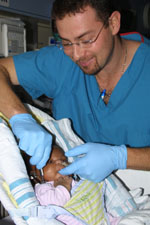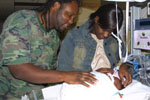On her own: infant benefits from new
surgical approach
by
Heather WoolwinePublic Relations
On Jan. 25, Nashia Gause began to breathe on her own for the first time since her birth on Dec. 14. Nashia was born with several syndromes, among the most debilitating, Pierre Robin sequence.
 Dr. Adam Ross,
gives Nashia, 6 weeks old, a finger to suck on post extubation while he
adjusts her devices.
Dr. Adam Ross,
gives Nashia, 6 weeks old, a finger to suck on post extubation while he
adjusts her devices. Little Nashia’s mandible, or lower jaw, was so small that it forced her tongue to the back of her throat, blocking her airway. After her initial cry at birth, eerie silence followed. Doctors in her hometown area of Marion performed an intubation so she could breathe. After trying to extubate (remove the breathing tube) her several times, Nashia was transferred to MUSC where David White, M.D., Otolaryngology-Head and Neck Surgery assistant professor and airway specialist, weighed options for her care. He consulted colleague Adam T. Ross, M.D., MUSC Facial Plastic and Reconstructive Surgery director, to discuss performing a new alternative procedure to the traditional option of placing a tracheostomy. Ross successfully performed the technique, dubbed distraction osteogenesis on children in similar situations during his training.
Never performed on a child of her size before at MUSC, Ross decided to execute a mandibular distraction to allow the tiny baby to breathe on her own.
A mandibular distraction involves the surgical cutting of both sides of the jaw and placement of steel, external devices on the outside of the jaw. Once the bone is cut, these devices allow for the slow movement of bone in the desired direction, and the body responds by creating new bone along the path of movement. “This multidisciplinary approach to a patient’s problem places MUSC in a minority of hospitals nationwide using this procedure on children this small, in addition to its use to avoid a tracheostomy,” Ross said.
After two-and-a-half weeks of slowly turning the devices three times a day by NNICU (neonatal intensive care unit) nursing staff, Nashia’s extubation on Jan. 25 demonstrated the first of what will hopefully be a long line of successful procedures for the delicate little girl.
“Each day for almost three weeks, the nursing staff turned the little pins in the device moving the jaw one and one half millimeters per day,” Ross said. “Because we haven’t done anything like this in the NNICU before, I gave an in-service to the nurses and NNICU physicians so they would understand exactly how to take care of Nashia during the distraction. With their help and her successful extubation, we’ve pulled the jaw out far enough for her to breathe on her own and she’s even begun to feed on her own as well. She’s doing incredibly well.”
With the device remaining in for at least the next three months, Nashia’s parents will be responsible for caring for it. “I’m just so glad that we decided to go this way instead of a trach (tracheostomy),” said April Gause, Nashia’s mother. “It would’ve been so much harder to take care of.”
Still the gold standard for many patients with airway problems, a tracheostomy involves cutting a permanent hole on the outside of the patient’s throat to allow open access to the airway. “By no means is this procedure obsolete, but there is a chance for major complications or even death (1 to 2 percent of patients) from a trach,” Ross said. “Mucous can become plugged in the hole, or the tube can become dislodged or pulled out by young children. Socially it comes with more of a stigma, but ultimately it’s up to the parents and what they believe will work best for them and their child.”
New to the Otolaryngology department, pediatric airway specialist White described some additional benefits to Nashia’s treatment. “This process is basically a few weeks long, whereas a tracheostomy could be in place for years before requiring a mandibular distraction anyway,” he said. “It’s an alternative to placing a tracheostomy tube which allows the child to avoid the complications associated with a trach. Children with trachs often have delayed speech, difficulty with physical, active play, and require intensive observation 24-hours-a-day. Suctioning must be available at all times, along with an experienced caretaker. It’s a difficult stigma for the children and for their parents, and it can be much more difficult to integrate a child into a daycare or school. With a tracheostomy tube, children are often seen as chronically diseased when they may be otherwise developmentally normal.”
 Nashia's parents,
Antwon Samuel and April Gause, comfort her as she awaits extubation.
Nashia's parents,
Antwon Samuel and April Gause, comfort her as she awaits extubation.“I’m just so glad and thankful that they thought about it,” April said. “It’s been hard to go through because I’m away from Quantisha (her 2-year-old daughter) and Antwon (Nashia's father). We knew that we were going to have work with her legs before she was born because of the ultrasound, but all of the rest of it we didn’t know about. I’m just so thankful to the Lord for all the help she’s gotten and how nice everyone here has been.”
Once Nashia finishes with her mandibular distraction, she will then begin examinations for treatment on her legs. In addition, Ross will repair her cleft palate around 1 year of age, and her doctors will pay close attention to her one functioning kidney, her heart defect, and how her lack of reproductive organs will affect her growth and development.
During Nashia’s time in the NNICU, April stayed at the Ronald McDonald House across the street from MUSC. She praised the staff at the house for helping her with so much and making her feel so cared for and welcome. Visiting on his days off, Antwon also kept vigil over his youngest daughter.
Once Nashia can feed well enough, she will be released from the hospital to begin her life at home with her parents and big sister.
Friday, Feb. 3, 2006
Catalyst Online is published weekly,
updated
as needed and improved from time to time by the MUSC Office of Public
Relations
for the faculty, employees and students of the Medical University of
South
Carolina. Catalyst Online editor, Kim Draughn, can be reached at
792-4107
or by email, catalyst@musc.edu. Editorial copy can be submitted to
Catalyst
Online and to The Catalyst in print by fax, 792-6723, or by email to
catalyst@musc.edu. To place an ad in The Catalyst hardcopy, call
Community
Press at 849-1778, ext. 201.